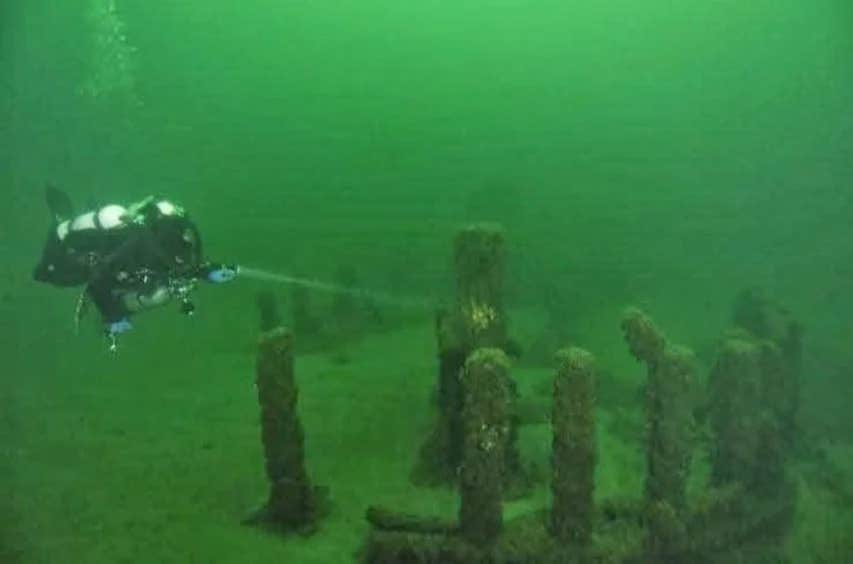9000-year-old ‘Stonehenge-like’ structure found at the bottom of Lake Michigan
Archaeologists recently unearthed a prehistoric structure in the bay that has drawn comparisons to England’s iconic Stonehenge

Situated approximately 40 feet beneath Lake Michigan’s glistening waters, within the heart of Grand Traverse Bay, this enigmatic discovery was to forever rewrite our understanding of the region’s ancient past. (CREDIT: CC BY-SA 4.0)
Grand Traverse Bay, known for its tranquil waters and rich maritime history, holds many secrets beneath its serene surface. Over the years, numerous shipwrecks have been discovered, attesting to the bay's bustling 19th and 20th-century trade routes. Recently, a groundbreaking discovery has added a new layer of intrigue to the bay's storied past.
Dr. Mark Holley, a distinguished underwater archaeology professor at Northwestern Michigan University, recently unearthed a prehistoric structure in the bay that has drawn comparisons to England's iconic Stonehenge. Located approximately 40 feet beneath Lake Michigan’s surface, this remarkable find is poised to transform our understanding of the region's ancient history.
The submerged stones, although smaller than those at Stonehenge, appear to be meticulously arranged. These stones, varying in size from basketballs to compact cars, form a meandering line over a mile long. Among them, a particularly notable rock stands out. It measures three and a half to four feet tall and five feet wide, and features a carving of a mastodon—a testament to an era when these majestic creatures roamed the Earth.
The stones are estimated to be around 9,000 years old, predating Stonehenge by about 4,000 years. This period follows the end of the Ice Age and the formation of Grand Traverse Bay, when the lake bed had not yet been submerged.
Charting Grand Traverse Bay
Stretching 32 miles in length and 12 miles in width, Grand Traverse Bay is nestled in the northeastern arm of Lake Michigan, bordered by Michigan's lower peninsula. Known for its underwater shipwreck dive sites, the bay attracts tourists who come to explore these sunken vessels with snorkels and fins.
Related Stories
The exact location of the Stonehenge-like structure remains a closely guarded secret. After his discovery, Dr. Holley informed the Grand Traverse Band of Ottawa and Chippewa tribes to show respect for their ancestral heritage and protect the site from damage. Consequently, the coordinates of this archaeological wonder are not disclosed to the public.
The submerged nature of the stones poses a significant challenge for archaeologists. Since their discovery in 2007, progress in studying the site has been slow, leading to widespread speculation about its significance. Researchers have looked to other regional stone formations for potential correlations, hoping to unravel the secrets of these underwater stones.
Similar stone structures in the vicinity provide tantalizing clues about the purpose of the Grand Traverse Bay arrangement. Dr. John O'Shea from the University of Michigan has studied a rock formation in Lake Huron, dating back 9,000 years. Situated 120 feet below the surface along the Alpena-Amberley Ridge, this stone assemblage is believed to have been used for ancient hunting practices, possibly to channel caribou.
Beaver Island, the largest island in Lake Michigan, also holds ancient stone formations. On the island's west side, along the Reddings Trail, a circle of glacial boulders is found, some marked with inscriptions. One stone even features a carved hole, suggesting it had a functional use. Although formal analyses like carbon dating are lacking, these stones are thought to have been significant to the Native American communities that once inhabited the island, possibly serving as calendrical markers or celestial observation points.
Unraveling the Mysteries
The purpose of the Grand Traverse Bay stone arrangement remains speculative. It could have been used by ancient caribou hunters, similar to the Lake Huron formation, or it might have served as an ancient calendar, aligning with celestial events like Stonehenge. The ambiguity highlights the need for further research and analysis, which is complicated by the underwater setting.
As technology advances, new methods of underwater exploration and analysis emerge, bringing us closer to understanding these ancient structures. Each discovery adds to our knowledge of the past, allowing us to glimpse the lives and practices of those who lived thousands of years ago.
In the coming years, the secrets of Grand Traverse Bay are likely to unfold further, providing invaluable insights into prehistoric life and the ancient peoples who once called this region home. Through meticulous research and respectful preservation, we honor their memory and enrich our understanding of the world’s ancient past.
Note: Materials provided above by the The Brighter Side of News. Content may be edited for style and length.
Like these kind of feel good stories? Get the Brighter Side of News' newsletter.
Joseph Shavit
Head Science News Writer | Communicating Innovation & Discovery
Based in Los Angeles, Joseph Shavit is an accomplished science journalist, head science news writer and co-founder at The Brighter Side of News, where he translates cutting-edge discoveries into compelling stories for a broad audience. With a strong background spanning science, business, product management, media leadership, and entrepreneurship, Joseph brings a unique perspective to science communication. His expertise allows him to uncover the intersection of technological advancements and market potential, shedding light on how groundbreaking research evolves into transformative products and industries.



